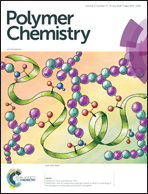Sustainable synthesis and characterization of a bisphenol A-free polycarbonate from a six-membered dicyclic carbonate†
Abstract
A bisphenol A (2,2-bis(4-hydroxyphenyl)propane, BPA)-free polycarbonate (PC) from a six-membered di-cyclic carbonate, di-trimethylolpropane di-cyclic carbonate (DTMPC), was developed as a new type of PC by ring opening homo-polymerization. The polymerization was controlled by using metal-free organic-based catalyst systems. The results indicated that the conversion rate depends on the basicity of the catalyst in the order of 1,5,7-triazabicyclo[4.4.0]dec-5-ene (TBD), 1,8-diazabicyclo[5.4.0]undec-7-ene (DBU), 4-dimethylaminopyridine (DMAP), and triethylamine (TEA) from high to low. Over 99% conversion of DTMPC was obtained at 130 °C within 15 min by TBD, DBU and DMAP. The resulting PC as a homo-polymer showed high optical transparency and hardness, low swelling property in organic solvents, and thermal stability at temperatures as high as 200 °C. A high cell viability and cyto-compatibility of C3H 10T1/2 cells seeded directly on the surface of PC films were obtained. This implied that PC is a viable material for biomedical and consumer products applications where safety is an important consideration.



 Please wait while we load your content...
Please wait while we load your content...